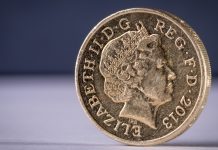Brexit nerves and strong US retail sales data sent the pound US dollar exchange rate lower on Friday. The pair dipped 0.6% to close at US$1.2594. Across the previous, week the pound dropped 1.1% against the dollar.
| What do these figures mean? |
|---|
| When measuring the value of a pair of currencies, one set equals 1 unit and the other shows the current equivalent. As the market moves, the amount will vary from minute to minute.For example, it could be written:1 GBP = 1.28934 USDHere, £1 is equivalent to approximately $1.29. This specifically measures the pound’s worth against the dollar. If the US dollar amount increases in this pairing, it’s positive for the pound. Or, if you were looking at it the other way around:1 USD = 0.77786 GBPIn this example, $1 is equivalent to approximately £0.78. This measures the US dollar’s worth versus the British pound. If the sterling number gets larger, it’s good news for the dollar. |
Brexit anxiety hit demand for the pound in the previous week, as the Conservative leadership race moved to the next round. Centrist Mark Hancock withdrawing from the race and hard-line Brexiteer Boris Johnson storming the first round has investors fretting over a no deal Brexit once again. Boris Johnson, who has emerged as the clear winner so far, has made no secret of his plans for Brexit, with or without a deal on 31st October.
This week the pound could remain out of favour as investors look towards inflation data, retail sales numbers and the Bank of England (BoE) policy announcement. Analysts are expecting inflation to have ticked lower to 2% year on year in May, don’t from 2.1%. Analysts also forecast that retail sales declined 0.8% month on month in May.
Signs of a slowing economy amid Brexit uncertainty and slowing global growth, could push the BoE policy makers towards a more cautious tone than they have had recently. With Boris Johnson charging ahead as the favourite to win the leadership race, the BoE may also start to question their base case scenario of the UK leaving the EU with a deal.
| Why is a “soft” Brexit better for sterling than a “hard” Brexit? |
|---|
| A soft Brexit implies anything less than UK’s complete withdrawal from the EU. For example, it could mean the UK retains some form of membership to the European Union single market in exchange for some free movement of people, i.e. immigration. This is considered more positive than a “hard” Brexit, which is a full severance from the EU. The reason “soft” is considered more pound-friendly is because the economic impact would be lower. If there is less negative impact on the economy, foreign investors will continue to invest in the UK. As investment requires local currency, this increased demand for the pound then boosts its value. |
Dollar Looks Towards Fed Midwek
The dollar received a boost at the end of last week. US retail sales jumped in May, beating analysts forecast. The data showed a pickup in consumer spending which eased investor fears over the health of the US economy. Data had otherwise been showing the US economy was heading for a sharp downturn in the second quarter.
This week could be a volatile week for the US dollar as investors look to the Federal Reserve’s monetary policy decision on Wednesday. Whilst market participants are not predicting a change in policy from the Fed, the Fed could adopt a more dovish tone amid ongoing trade tensions.
| Why do raised interest rates boost a currency’s value? |
|---|
| Interest rates are key to understanding exchange rate movements. Those who have large sums of money to invest want the highest return on their investments. Higher interest rate environments tend to offer higher yields. So, if the interest rate or at least the interest rate expectation of a country is relatively higher compared to another, then it attracts more foreign capital investment. Large corporations and investors need local currency to invest. More local currency used then boosts the demand of that currency, pushing the value higher. |
In addition to the Fed rate decision, investors will be watching the lead up to the G20. Confirmation that President Trump and China’s President Xi Jinping will meet at the G20 could offer hope of trade tensions easing.
This publication is provided for general information purposes only and is not intended to cover every aspect of the topics with which it deals. It is not intended to amount to advice on which you should rely. You must obtain professional or specialist advice before taking, or refraining from, any action on the basis of the content in this publication. The information in this publication does not constitute legal, tax or other professional advice from TransferWise Inc., Currency Live or its affiliates. Prior results do not guarantee a similar outcome. We make no representations, warranties or guarantees, whether express or implied, that the content in the publication is accurate, complete or up to date. Consult our risk warning page for more details.
This article was initially published on TransferWise.com from the same author. The content at Currency Live is the sole opinion of the authors and in no way reflects the views of TransferWise Inc.





